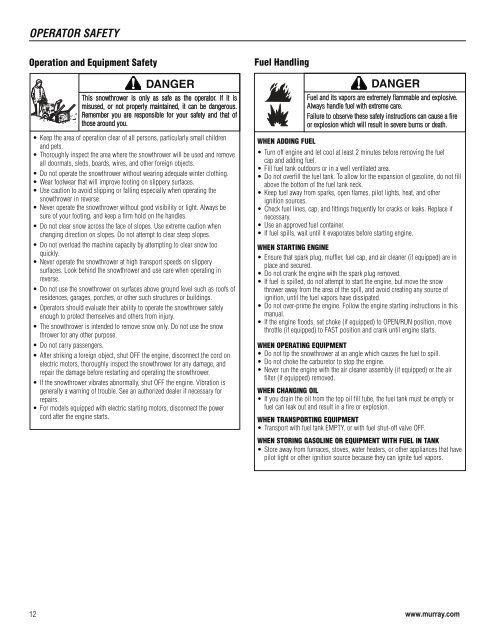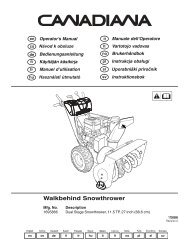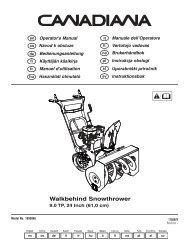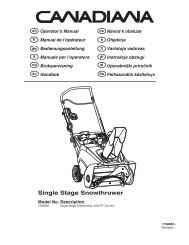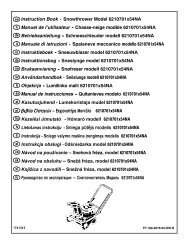Walkbehind Snowthrower - Canadiana
Walkbehind Snowthrower - Canadiana
Walkbehind Snowthrower - Canadiana
- No tags were found...
You also want an ePaper? Increase the reach of your titles
YUMPU automatically turns print PDFs into web optimized ePapers that Google loves.
OPERATOR SAFETYOperation and Equipment SafetyDANGERThis snowthrower is only as safe as the operator. If it ismisused, or not properly maintained, it can be dangerous.Remember you are responsible for your safety and that ofthose around you.• Keep the area of operation clear of all persons, particularly small childrenand pets.• Thoroughly inspect the area where the snowthrower will be used and removeall doormats, sleds, boards, wires, and other foreign objects.• Do not operate the snowthrower without wearing adequate winter clothing.• Wear footwear that will improve footing on slippery surfaces.• Use caution to avoid slipping or falling especially when operating thesnowthrower in reverse.• Never operate the snowthrower without good visibility or light. Always besure of your footing, and keep a firm hold on the handles.• Do not clear snow across the face of slopes. Use extreme caution whenchanging direction on slopes. Do not attempt to clear steep slopes.• Do not overload the machine capacity by attempting to clear snow tooquickly.• Never operate the snowthrower at high transport speeds on slipperysurfaces. Look behind the snowthrower and use care when operating inreverse.• Do not use the snowthrower on surfaces above ground level such as roofs ofresidences, garages, porches, or other such structures or buildings.• Operators should evaluate their ability to operate the snowthrower safelyenough to protect themselves and others from injury.• The snowthrower is intended to remove snow only. Do not use the snowthrower for any other purpose.• Do not carry passengers.• After striking a foreign object, shut OFF the engine, disconnect the cord onelectric motors, thoroughly inspect the snowthrower for any damage, andrepair the damage before restarting and operating the snowthrower.• If the snowthrower vibrates abnormally, shut OFF the engine. Vibration isgenerally a warning of trouble. See an authorized dealer if necessary forrepairs.• For models equipped with electric starting motors, disconnect the powercord after the engine starts.Fuel HandlingDANGERFuel and its vapors are extremely flammable and explosive.Always handle fuel with extreme care.Failure to observe these safety instructions can cause a fireor explosion which will result in severe burns or death.WHEN ADDING FUEL• Turn off engine and let cool at least 2 minutes before removing the fuelcap and adding fuel.• Fill fuel tank outdoors or in a well ventilated area.• Do not overfill the fuel tank. To allow for the expansion of gasoline, do not fillabove the bottom of the fuel tank neck.• Keep fuel away from sparks, open flames, pilot lights, heat, and otherignition sources.• Check fuel lines, cap, and fittings frequently for cracks or leaks. Replace ifnecessary.• Use an approved fuel container.• If fuel spills, wait until it evaporates before starting engine.WHEN STARTING ENGINE• Ensure that spark plug, muffler, fuel cap, and air cleaner (if equipped) are inplace and secured.• Do not crank the engine with the spark plug removed.• If fuel is spilled, do not attempt to start the engine, but move the snowthrower away from the area of the spill, and avoid creating any source ofignition, until the fuel vapors have dissipated.• Do not over-prime the engine. Follow the engine starting instructions in thismanual.• If the engine floods, set choke (if equipped) to OPEN/RUN position, movethrottle (if equipped) to FAST position and crank until engine starts.WHEN OPERATING EQUIPMENT• Do not tip the snowthrower at an angle which causes the fuel to spill.• Do not choke the carburetor to stop the engine.• Never run the engine with the air cleaner assembly (if equipped) or the airfilter (if equipped) removed.WHEN CHANGING OIL• If you drain the oil from the top oil fill tube, the fuel tank must be empty orfuel can leak out and result in a fire or explosion.WHEN TRANSPORTING EQUIPMENT• Transport with fuel tank EMPTY, or with fuel shut-off valve OFF.WHEN STORING GASOLINE OR EQUIPMENT WITH FUEL IN TANK• Store away from furnaces, stoves, water heaters, or other appliances that havepilot light or other ignition source because they can ignite fuel vapors.12 www.murray.com


